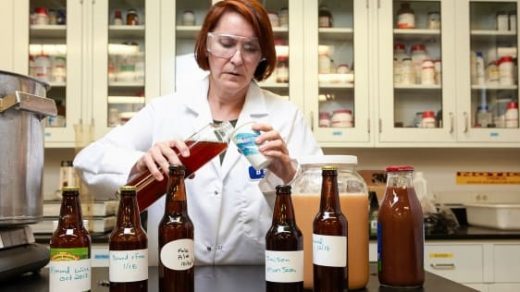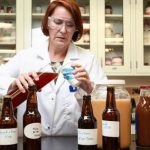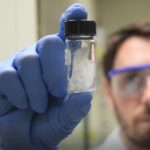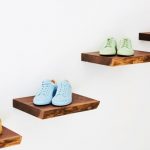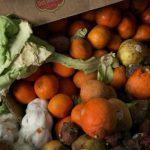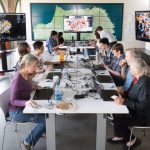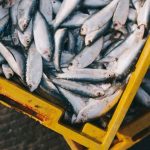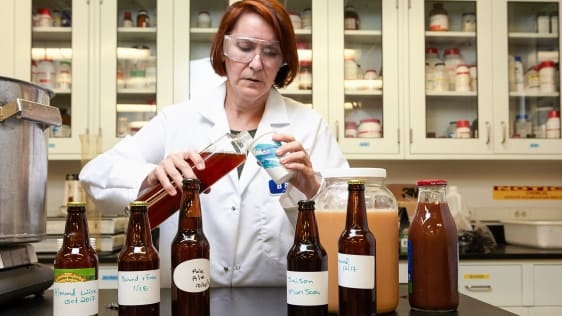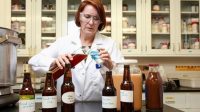This USDA Lab Is Turning Billions Of Pounds Of Almond Waste Into Beer, Plastic, And Power
Inside a USDA research building near Berkeley, California, research leader Bill Orts holds up a mottled-looking black plate. It’s “really ugly,” he says. But the rough prototype is the first of its kind, made with recycled plastic and almond shells that were transformed into a charcoal-like black powder in an on-site lab. By adding the powder to bio-based or recycled plastics, the materials get stronger. For the almond industry, it’s one possible way to make the best use of everything grown in an almond orchard.
On almond trees, each tiny almond grows inside a shell and a larger, apricot-like hull. In 2017, almond farmers in California grew 2.1 billion pounds of the kernels that are sold in stores, and another 4.3 billion pounds of hulls. “For every pound of almonds we produce, we get two pounds of hulls,” says Danielle Veenstra, an almond farmer who also works with the Almond Board of California, an industry group. “We’re always trying to figure out the best use of these.”
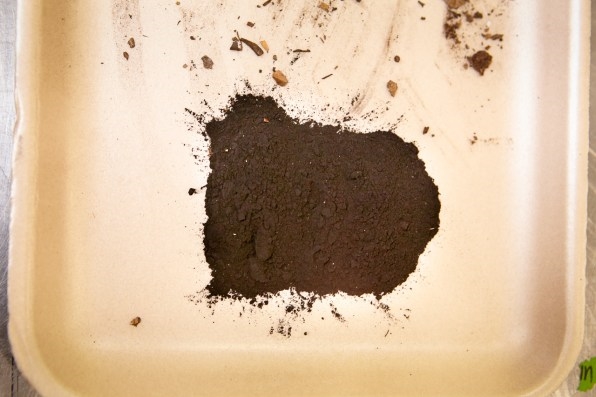
In the past, the hulls–which smell sweet, a little like the fruit of their relatives, peaches and plums, but are a little bitter for human palates–have mostly been fed to cows. The smaller shells are often used in livestock bedding. But as the dairy industry in California has been shrinking, and the almond industry has grown, the market value of the hulls and shells has dropped, and almond farmers and hullers have started looking for different uses. (The decline of dairy and growth of almonds are not unrelated, as almond milk has replaced some dairy milk sales.)
The shells and hulls could be used in “cogeneration” plants to make electricity. “At the lowest end of the value chain, you can put almost anything in a digester and make methane,” says Orts. “You could compress them and almost treat them like coal.” The sugar in the hulls can also be extracted to make ethanol; when the Almond Board first began working with the USDA research center eight years ago, they wanted to explore making biofuel. The Wonderful Company, the world’s largest grower of tree nuts, plans to build a biofuel plant that will convert almond shells to renewable diesel.
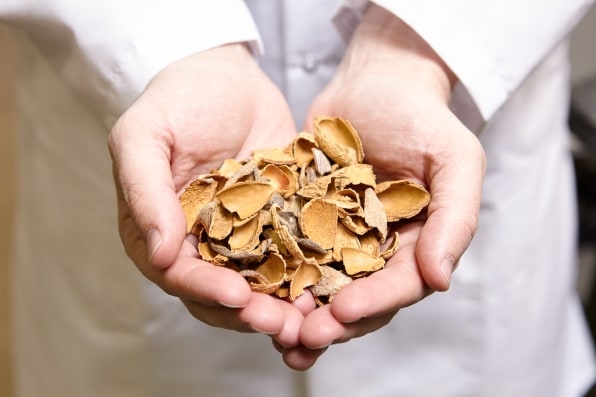
But biofuel plants cost millions to build, and the fuel itself may not necessarily make much money. The USDA researchers are focused on alternatives that could have higher value than burning the material for energy. The lab has long experience with bio-based plastics. Orts holds up a slightly melted fork, an early prototype from Worldcentric, a company that makes compostable dinnerware, which first worked out of USDA’s pilot plant and still has researchers working in the building. Using bio-based additives in the next version of the fork made it stable enough to survive boiling water. The new almond shell powder could similarly be used as an additive to help bioplastics stronger and more heat-stable. Startups that are based in the USDA building working on alternatives to plastic packaging, like Full Cycle Bioplastics, could incorporate the material into compostable products.
It could also improve recycled plastic. “A lot of plastic manufacturers want to use postconsumer recycled plastic, but it’s usually downcycled,” Orts says. “It’s usually a plastic that doesn’t have the stiffness or heat stability that they really want.” The blackened almond shells can also turn plastic an even shade of black. “If you just have the usual blob of recycled plastic, it’s usually gray,” he says, showing me a sample of a gray bottle of Method soap that the USDA researchers helped make out of recycled ocean plastic. The material could also be used to turn tires black, replacing the petroleum product that the tire industry usually uses.
In a cavernous lab, researchers are working on several other uses for the material. The sugar from the hulls can be used to make a hard cider or beer. “You can make really bitter IPAs,” says Orts. “There’s a market for that.” It’s possible to naturally filter out some of the bitterness of the almond hulls; after early feedback from a major beer manufacturer, the researchers are working on adjusting the flavor.
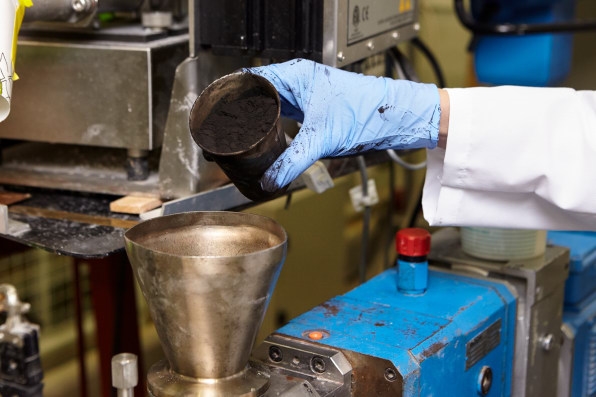
The sugar could also be used to make tea, or as an alternative to high-fructose corn syrup as an ingredient. The researchers are also experimenting with feeding it to bees; the honeybees that work in California orchards are typically fed corn syrup to make it through the winter. “The bees hate [corn syrup]–they’re not healthy,” says Orts. Instead of bringing corn syrup from the Midwest for beehives, it might be possible to feed them almond sugar instead.
Once sugar is extracted from the hulls, either for people or bees, the hulls could be used to grow mushrooms. In another corner of the lab, researchers are studying how well mushrooms grow on the hulls compared to peat moss, which is typically imported from other countries.
On farms, the Almond Board is also experimenting with adding shells and hulls to the soil to improve soil quality and reduce pests. But at the USDA lab, the goal is to tempt companies to bring the new products to market. “An academic lab might give somebody an idea that gives you a reason to believe [a startup could work],” Orts says. “We give you a prototype that gives you a reason to believe.”
Once a business sees that a particular prototype can work, it typically starts working with the lab. “The reason McDonald’s is selling 65 million pounds of apples was developed in the lab right across from where I’m standing,” he says. A USDA researcher discovered a way to keep apples from browning for 40 days; that powder, essentially a mix of vitamins, enabled McDonald’s and Subway to start selling packages of cut apples.
Something similar could happen for almond hull beer or almond-enhanced plastic. Some niche industries–like premium mushroom growers, or the manufacturers of flower pots, who want to use recycled plastic but don’t like the fact that pots can sometimes start to melt together in the hot sun–are ready to buy the products, and just waiting for someone to bring them to market. “It’s about finding a business plan,” says Orts. “How do you go from this crazy thing to a marketable thing? Then somebody actually has to take a risk and commit money.”
(42)

